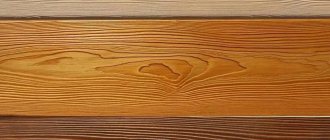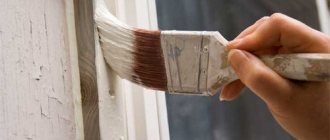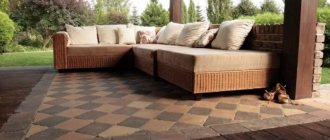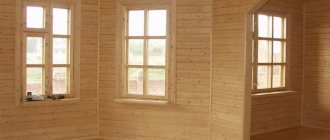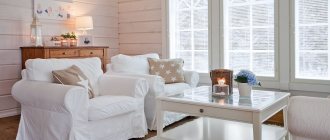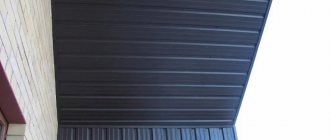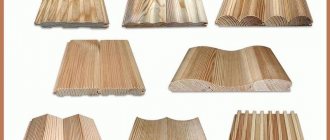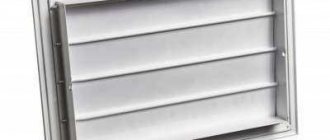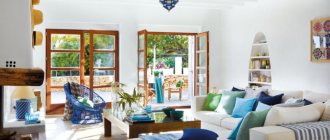An increasing number of homeowners, when choosing a finishing coating for interior walls, give preference to a natural material - wood. This choice is not surprising, because wood combines many useful properties: environmental friendliness, health benefits, beautiful appearance. These qualities are complemented by excellent performance characteristics: low weight, good sound and heat insulation. The simplest and most affordable wooden finishing material is considered to be lining, a thin cladding panel with a tongue-and-groove joint. Painting the lining inside the house is a necessary stage in the finishing of the home, allowing you to give the interior a complete look and solve several additional problems.
Lining in the interior: stylish living room of a country house Source de.decoratex.biz
About the need to process the lining
Many people sincerely believe that walls covered with wood panels are beautiful in their natural appearance and do not require additional processing. Knowledgeable people have several reasonable objections to this; they indicate the need to protect sheathed walls from the following factors:
- Actions of ultraviolet radiation . If a wall covered with clapboard is regularly exposed to sunlight, over time the wood will darken and the walls in the room will begin to look different.
- Color changes . If the ventilation system in the house is poor, the air begins to stagnate. In places of high humidity, microorganisms develop and wooden lining may turn blue.
- Damage to the structure . In a room with excess humidity, wood easily harbors pests and mold; this causes rotting and destruction of the finishing layer.
- Mechanical damage . A layer of paint and varnish will absorb scratches and impacts and will not spoil the beauty of the walls.
- From fire . It is considered reasonable and prudent to protect wooden surfaces from the rapid spread of flame.
Unprotected lining is an easy target for destructive factors. Source drewinwest.com
Sometimes owners think about changing the interior. Lining can be easily updated - there are dozens of coating options and hundreds of shades that make it possible to make familiar rooms unrecognizable.
There is no clear answer to the question of how to paint wooden panels inside a country house. The choice is determined by the goals - whether the owners only want to protect wooden walls, refresh tarnished surfaces or radically change the color. Materials suitable for processing lining can be divided into two types: protective and decorative.
What nuances should be taken into account when working with lining
Sheathing is a board of varying thicknesses made from different types of wood. This material got its name from the place where it was first used. These are train cars whose interior walls are lined with small wooden boards. Today it is fashionable to cover the walls with boards in the bathroom, as well as in the sauna or gazebo.
It should be borne in mind that decorating walls with clapboards with your own hands requires an integrated and balanced approach. Please pay attention to the following details:
- Packaged cards should be stored horizontally on the mat.
- The humidity in the warehouse should be within normal limits.
- Do not store in direct sunlight on the packaging.
- It is important to pay attention to the expiration dates indicated on the packaging.
- The cost of 1 m2 of distilled linden, which can easily withstand temperature changes and high humidity, costs 500 rubles, and for wall cladding in the main rooms of the dacha, on average, you can leave a smaller amount - 300 rubles per m2. Important! The price of the material directly depends on the quality of the wood.
On a note! Wall cladding is purchased with a reserve of ten percent of the total area. It should be remembered that the width of each element is measured by the internal depth, so it is necessary to subtract 10-12 mm from the depth of the groove.
Protective compounds
There are many ways to protect a wooden surface from the damaging effects of external factors. The following substances can be used to protect the panel covering:
- Fire retardants . This group of compounds is recommended for use in rooms with wooden walls or coverings. Fire retardant impregnation is not capable of stopping combustion, but can significantly delay the spread of fire. This time will be enough to leave the room and call the fire department, and maybe even handle the fire yourself.
Painted lining is protected from the effects of solar ultraviolet radiation Source rmnt.mirtesen.ru
Fire retardants practically do not change the appearance of the wooden surface, and do not emit harmful substances during operation.
- Antiseptics . Products with bactericidal properties are used in the fight against biothreats - they are used as a preventive measure, but they are also effective if fungal infection has already begun. The inconvenience of antiseptic treatment is that it must be repeated periodically, since the compositions tend to evaporate. Recently, complex impregnations have appeared that not only cope with mold and wood-boring beetles, but also perform the functions of varnish and stain. Such “three-in-one” antiseptics create a film on the surface, are more expensive, but additionally protect the lining from moisture and give it an impressive look.
- Wood stain . A type of antiseptic impregnation that can penetrate deep into the structure of wooden panels and protect them from unwanted parasitic guests. An additional advantage that makes stain popular is its ability to paint the surface a deep dark color. The downside of the product is that panels soaked in it will appear dull and dirty if you do not apply a layer of varnish on top.
Processing lining with stain Source nastroike.com
- Flaxseed oil . It is used both for the production of quick-drying varnishes and drying oils, and as an independent impregnation with valuable qualities. Oil is a natural agent that gives the lining water-repellent properties and makes it insensitive to microorganisms. The oil penetrates deep into the material without creating a film on the surface and allows the wood to breathe. A surface impregnated with linseed oil reveals its texture more clearly and acquires a light tint. Impregnation with linseed oil, although relatively inexpensive, will cost more than treatment with stain or varnish.
- Drying oil . There are natural, synthetic and combined drying oils. Every year they are used less and less - this is not the most attractive set of qualities: over time, the surface impregnated with drying oil turns yellow and becomes sticky.
- Primer . Before using varnish or paint, the wooden surface is treated with a primer. This base protects the wood from moisture and reduces the consumption of paints and varnishes. The decorative layer is more even and attractive in appearance.
Using a primer improves the quality of the base coating Source dekoriko.ru
See also: Catalog of companies that specialize in paints and varnishes.
- Bleaches . A group of products that allow you to get rid of stains of various natures that appear on wooden surfaces. Bleach is applied to the problem area and then washed off with water.
- Lucky . The varnish has not only protective, but also decorative functions, which is why it is often chosen for treating lining walls and ceilings. One of the best options for indoor use is acrylic varnish. It is usually applied in two layers - the first is transparent, and the second can be tinted. Water-based varnish (aqualak) can create different effects - after using it, the walls become glossy, matte or semi-matte. Aqualak creates a vapor-permeable film on the lining, often with protection from ultraviolet radiation and microorganisms.
- Wax . Wax mixtures are a classic product with effective protection. They give the wood a semi-matte shine and serve as a good alternative to varnish. Manufacturers offer hard wax (heat it up before use), as well as liquid and water-based wax (ready-to-use). The wax composition is difficult to distribute evenly, but preliminary application of the primer significantly facilitates this process.
Wax-polished lining is always in fashion Source opora-stroy.ru
Photo ideas
Polar color - painting brushed wood in two layers - Exclusivewood.rf
11. We paint the lining with oil brushing with our own hands!
Decorative (covering) products
Decorative means are those that make the color and texture of wood trim invisible. Sometimes they are used to hide a wooden surface that has darkened over time. Decorative options for painting linings inside the house are pleasantly varied; These include the following types of paint and varnish products:
- Oil paint . An old, tried-and-true way to protect and refresh a wall is to coat it with oil-based paint, creating a thick, moisture-proof layer. The downside is that the paint takes a long time to dry and has a strong smell. Because of this, it is recommended to carry out the work in the warm season, when the walls are dry and the smell disappears as quickly as possible.
- Acrylic (acrylate) paint . In many ways it is a better quality, easier-to-work material than oil-based paint. It does not lose color and shine, creates a waterproof elastic film on the surface that does not violate its integrity during temperature fluctuations. The paint is easy to use - it dries quickly and fades away.
Lining coated with acrylic paint in the interior of the living room Source roomester.ru
Having chosen to paint the lining inside the house with acrylic paint, it would be correct to use it to decorate the walls in the bedroom and nursery - it is absolutely harmless. The only thing that spoils the impression of acrylic paint is its high price.
- Acrylic aqualak . An environmentally friendly product that is gaining popularity can simultaneously decorate and protect clapboard walls. The product has a high degree of protection against microorganisms, does not have an unpleasant odor after drying, and when applied goes on smoothly, without marks or streaks. Painting the lining inside the house with acrylic aqualac has its own separate advantage - a wide palette of colors, allowing you to create an original interior.
- Alkyd varnish . This type of paint and varnish products is used mainly in rooms that require regular wet cleaning (kitchen, hallway, living room). Colored varnish is resistant to abrasion, while colorless varnish is also resistant to water. Disadvantage: alkyd varnishes take a long time to dry and are expensive.
- Decorative glaze . Used as an independent decorative composition. Can be transparent or colored; in both cases, it favorably emphasizes the texture of wooden panels and protects them from moisture.
Carrying out the procedure
To paint wooden panels, paint or varnish with colors and dyes of different types and compositions is used (how to properly varnish a panel for a long time?). Application techniques and finishing methods depend on the composition of the paintwork material.
Varnish
To paint wooden panels with varnish you will need:
- check all existing lining, sort it by color and quality, exclude panels that contain falling knots or other obvious defects;
- thorough sanding is carried out until absolutely smooth to the touch is achieved;
- if necessary, cover with a special primer or apply the first base layer of varnish, leave each canvas to dry without touching the treated surface;
- if an opaque varnish is used, then repeated sanding over the painted layer is necessary;
- A second layer of varnish is applied until the color is uniform over the entire area of the canvas, and then dried.
Tip Rejected panels can be used as test panels. On them you can see the type of coating with different numbers of layers, etc.
You can watch how to properly varnish the lining, what tools and techniques to use for this, in the following video:
Dyeing white
To create the desired decorative effect, several coloring techniques are available:
- Acrylic pigment primer diluted to 80-100% is applied like a regular varnish. It creates a coating with a long service life, but its price is high.
- Polyurethane pigment primer labeled “bleached” or “white” with a dilution of up to 80-100% also provides the desired decorative effect, but over time the color becomes yellow.
- Oil with wax - with a single-layer coating requires rubbing with a rag to preserve the wood texture; with a two-layer finish the surface is opaque.
- Tinting or staining - often found with the markings “bleached oak”, “frost” and the like. The peculiarity of the finishing is a multi-layer coating with very thin and uniform films. Otherwise, a peeling effect will form on the surface.
These methods provide different shades of white, depending most on the type of wood.
You can learn how to quickly and correctly paint the lining white from this video:
Technicians
For high-quality painting of lamellas, the following rules must be followed:
- Dry lining is processed only from the outside, and a wet panel must either be pre-dried or processed on all sides, including the ends. This is especially true for rooms with high humidity.
- The coating is applied to each plank separately to achieve an even color over the entire surface and to prevent the appearance of visible boundaries between strokes.
- When painting lining that is already installed on the wall, it is difficult to achieve maximum filling of the joints, so you need to choose a special brush.
- It is necessary to adhere to the technology recommended by experts for painting tongue-and-groove wooden lamellas.
Attention If the quality of the first layer remains below average, then it must be sanded and primed again. Apply paint only to dry boards. This approach will even out the density over the entire surface of the material to ensure a uniform shade
This approach will even out the density across the entire surface of the material to ensure a uniform shade.
Often they cover surfaces that are already installed on the wall. Therefore, the technology may differ slightly. You need to paint along the board, but with movement from one edge, for example, from one doorway to another. This will provide more even coverage as there will be no wet transitions.
Painting: features and nuances
Having chosen what to paint the wooden lining inside the house with, they begin the painting process. In order for the result to be of high quality and delight the owners for many years, the following preparatory work must be completed:
- Stock up on tools . You will need paint brushes and a tray, the chosen paint material, a roller with interchangeable attachments, a bucket, fine-grained sandpaper and protective gloves.
- Clean the surface . The lining is cleaned of dust, dirt, and old coating with a stiff brush or pumice stone, then treated with sandpaper.
- Degrease the wood . Treating the surface with an alkaline detergent will improve the adhesion (adhesion) of paint to wood.
- Carry out grinding . You can level the surface using pumice, sandpaper or sanding mesh. The defects are first filled with putty, and the resin is removed with a solvent.
Minimum set for painting wooden panels Source sovkalmykia.ru
- Pre-treat the lining . A primer is applied, and after it dries, an antiseptic impregnation is applied. The process can be accelerated if you purchase a combination composition that combines both products.
- Paint the walls . After waiting for the primer and antiseptic to dry, begin painting. Paint for lining inside the house is applied in two or three layers. The number of layers depends on the selected material and is indicated in the instructions. It is possible to paint wooden panels well before installing them on the walls, but this is not always possible (the procedure requires a large awning or canopy).
Functional impregnations-flame retardants
Such formulations are intended to provide a protective coating
Paints containing fire retardants resist fire, which is important in the countryside - especially in the summer. Impregnations can be used either alone or as an addition to other paints
The composition penetrates the wood structure and increases its resistance to combustion processes.
Advantages of products with flame retardants:
- Effective performance of the fire safety function;
- Possibility of combination with decorative compositions;
- Ease of processing;
- Acceptable level of environmental friendliness.
Flaws:
- The composition has no decorative function;
- Limited functional action (mainly fire protection);
- Requires compatibility with specific wood.
Useful tips for painting lining
Some subtleties of the workflow will help make the painting better. When processing wooden panels, the following points are taken into account:
- reduce the cost of painting . Tinted varnish or oil-wax is more expensive, but the effect of its use will be greater.
- Pre-impregnation of the lining should be done on all sides , this will significantly enhance the protective effect.
- When working with oil paint, you should take into account its tendency to change color (fading). To prevent color changes from becoming noticeable over time and spoiling the interior, you should choose darker, more saturated shades .
- It is better not to paint on a hot day , as the coating will dry too quickly and apply unevenly (spots of varying saturation may remain).
- In order for the coating to be uniform in color be stirred periodically during operation .
The coating is applied along the fibers of the lining Source nauka-i-religia.ru
- To ensure that the color of the walls is uniform , you can add the color of the finishing material (paint) to the primer.
- When choosing a paint composition, total costs are taken into account : not only its cost, but also the recommended number of layers, as well as paint consumption per 1 m².
Colored wax for wood
Oil wax for wood is not a metaphor, but an oil-wax composition!
- oil and wax for wood (bees), 1 liter per 12 -15 sq.m.
- oil with hard wax for wood (carnauba), 1 liter from 20 sq.m.
- All products come with ready-made factory tinting
- our coatings never peel off
- are not afraid of moisture and temperature changes
- 100% organic without added chemicals
- Application demonstration before purchase
- delivery to regions
- discounts
Choosing a color for painting the lining
Walls lined with clapboard are the backdrop for creating the interior of a country house, so choosing the appropriate shade is a task no less important than choosing the optimal paint and varnish composition. To ensure that the choice of color for wooden panels does not disturb the harmony of the design, the following rules are followed:
- For the walls, choose a shade that differs no more than a few tones from the color of the ceiling and floor. Contrasting transitions will harm the overall style (only if the interior is not designed in any of the avant-garde styles).
- White color is a classic way to expand a space and make it lighter. It adds elegance to the interior, goes well with other shades and hides surface defects well.
Warm colors are welcome in bedroom design Source bookdifferent.com
- In the design of the living room and kitchen light and warm shades look best : cream, peach, brown.
- The children's interior allows the use of bright colors (for which high-quality and safe acrylate paints are ideal). In the bedroom , walls lined with wood panels are varnished in natural shades or soothing colors - lilac, beige, honey. Gray-blue or brown-green colors are suitable for decorating the walls of the office
How to calculate the required amount of paint
Any repair or construction must begin with an estimate and detailed instructions. Consumables, such as paint for lining, must be purchased in reserve. When making calculations, one should take into account the characteristics of the surface, tools, professionalism of the work performers, the number of layers and the texture of the mixture.
If the entire room is to be painted, then first of all it is necessary to determine its perimeter. We take away the area of doors, windows, openings and other untreated surfaces. The result obtained must be compared with the standard consumption of the selected type of paint. Manufacturers place this information on the product label. You need to understand that the quantity is indicated taking into account the work under ideal conditions, for one layer of painting.
Aging effect
You can make the interior of a room attractive and original by artificially aging finishing materials. Natural lining without coating looks monotonous. You can add antique value to it in several ways:
- Brushing. Suitable for pine or oak. The top layer of the rock is removed with a coarse brush, sanded and covered with stain of any color, for example, wenge;
- Pantination. Use two colors of paint, slightly different shades. The first enamel is applied in a thick layer and allowed to dry. Then paint a thin layer of lighter paint. After complete drying, rub the surface with sandpaper. The illusion of numerous repainting of the lining is created;
- Paraffin treatment. Wax is applied unevenly to individual areas. Then the pantining process is repeated. After drying, remove it with a spatula and treat the board with stain. The result is a worn effect.
Materials for interior painting
When selecting the necessary tool, it is necessary to take into account that before painting the surface must be treated with anti-rot compounds. With this in mind, you should stock up on the following materials:
- Coarse sandpaper to clean the surface from dirt and foreign matter. This is especially necessary for lower grade linings, the technical conditions for which require the presence of resin pockets - if they are not cleaned out, the painting will not be of high quality.
- Set of painting tools. In addition to the traditional flat brush, you also need a wool roller, a bucket, and a spray gun/spray gun. For tall rooms, a stepladder may also be required.
- Safety glasses and a gauze bandage - if it is impossible to work in a well-ventilated area.
- For priming and antiseptic treatment, it is better to have a separate set of painting supplies, since it is not known in advance how dissimilar coatings will interact with each other.
